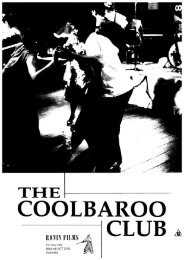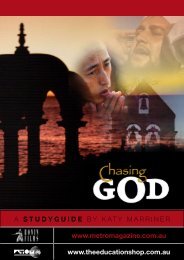to download PAPA BILONG CHIMBU study guide - Ronin Films
to download PAPA BILONG CHIMBU study guide - Ronin Films
to download PAPA BILONG CHIMBU study guide - Ronin Films
Create successful ePaper yourself
Turn your PDF publications into a flip-book with our unique Google optimized e-Paper software.
A STUDY GUIDE by kate raynor<br />
http://www.metromagazine.com.au<br />
http://www.theeducationshop.com.au
A Complicated Legacy:<br />
'Papa Bilong Chimbu'<br />
I was privileged <strong>to</strong> observe the culture and<br />
the cus<strong>to</strong>ms of the Chimbu people before<br />
any influence from outside. I have given the<br />
best part of my life <strong>to</strong> the Chimbu, and I’m<br />
still very attached <strong>to</strong> these people, who have<br />
given me the name ‘Papa of the Chimbu’.<br />
My life has been long, and I think fruitful. I am<br />
very grateful <strong>to</strong> God for my religious, priestly<br />
and missionary vocation, and <strong>to</strong> the people<br />
of Papua New Guinea. – Father John Nilles<br />
Introduction<br />
In 1937 a young Catholic missionary, Father John Nilles<br />
(1905-1993), arrived in the Highlands of Papua New<br />
Guinea. There he would stay for the next fifty-four years,<br />
living with the people of Chimbu, learning their language<br />
and way of life, introducing them <strong>to</strong> his God and Western<br />
culture. More than just a priest, he would become an<br />
anthropologist, linguist, politician and clan leader. Through<br />
Nilles’ extraordinary archive of pho<strong>to</strong>s, diaries and letters,<br />
as well as interviews with those who knew him, filmmaker<br />
Verena Thomas pieces <strong>to</strong>gether a portrait of this fascinating<br />
man – her great-uncle. What she discovers is an unexpected<br />
new family, who had made ‘Papa’ Nilles one of their<br />
own. The tremendous respect with which the Chimbu people<br />
of the Highlands continue <strong>to</strong> regard her great-uncle is<br />
evident in the warm and friendly reception Thomas receives<br />
when she first visits the Dimbi region, some twelve years<br />
after Nilles’ death.<br />
John Nilles on his<br />
arrival in 1937<br />
Papa Bilong Chimbu sets out the stark dangers involved in<br />
missionary work. Goldminers and missionaries were the first<br />
white people <strong>to</strong> venture in<strong>to</strong> the remote, unexplored hinterland<br />
beyond the Bismarck Range, where half a million people<br />
could be found, living in isolated tribes, still using <strong>to</strong>ols from<br />
the S<strong>to</strong>ne Age. In 1935 Father Morscheuser, a Catholic<br />
missionary stationed in PNG, was murdered. Father Nilles<br />
became the first missionary <strong>to</strong> move in<strong>to</strong> the area – what he<br />
called ‘the oceanic paradise garden’ – after that tragic event.<br />
Nilles’ compassion and intellectual discipline made him an<br />
authority on this region and its people’s beliefs and cus<strong>to</strong>ms.<br />
Papa Bilong Chimbu offers a thought-provoking insight in<strong>to</strong><br />
the complexity of cultural exchange. It is an important film<br />
for the information it provides on a particular<br />
socio-his<strong>to</strong>rical moment, presenting a<br />
personal perspective on the his<strong>to</strong>ry of one of<br />
our nearest neighbours. It highlights the ways<br />
in which the missionary’s quest has informed<br />
the shape and development of our world.<br />
Maria Waigl and<br />
Martha Mogl<br />
Papa Bilong Chimbu is also a compelling<br />
character <strong>study</strong>. As Thomas puts it, this is<br />
the s<strong>to</strong>ry of a man who became part of a big<br />
family: both the man and the family deserve<br />
investigation. Finally, the film works well as<br />
a lively visual document, utilizing a wide and<br />
interesting array of resources that students<br />
should find engaging.<br />
SCREEN EDUCATION<br />
2<br />
captions
Discussion Points<br />
and Activities<br />
Curriculum Links<br />
Mariana Ambake<br />
Papa Bilong Chimbu could be used in a range of age and curriculum<br />
contexts. It has application in Social Studies, Religious Studies,<br />
Anthropology and Philosophy. At senior secondary and tertiary levels,<br />
it could be situated in a <strong>study</strong> of post-colonial discourse, examining<br />
the complex legacies of missionaries. It could also be utilized as<br />
anintroduction <strong>to</strong> issues of anthropology. For junior secondary levels, it<br />
supports an explora tion of the his<strong>to</strong>ry and culture of one of our nearest<br />
neighbours, providing a context within which <strong>to</strong> explore current and past<br />
relationships between Australia and Papua New Guinea.<br />
Discussion Points and Activity<br />
Suggestions<br />
The following activities include some basic comprehension<br />
and information-gathering exercises and a<br />
range of straightforward projects.<br />
The many discussion points can be used in a variety of ways:<br />
as the focus for sustained writing activities – argumentative,<br />
opinionative or creative; as basic research <strong>to</strong>pics; and as <strong>to</strong>pics<br />
for class forums, oral presentations or debates. This provides<br />
the opportunity <strong>to</strong> assess a variety of (critical) literacy<br />
skills. Students at junior levels may require more scaffolding,<br />
and teachers are encouraged <strong>to</strong> pick and choose as appropriate<br />
for the needs and strengths of specific classes and<br />
students. Given the wide age range of students that could<br />
<strong>study</strong> this film, an attempt has been made <strong>to</strong> present <strong>to</strong>pics<br />
with varying degrees of complexity and sophistication.<br />
N.B. Students conducting research should be informed that<br />
the PNG province Chimbu is also called Simbu.<br />
PNG: The Vineyard of the Lord<br />
‘The air was cool and crisp, the people strong:<br />
muscular men, gracefully striding women, smiling<br />
children with unwashed faces. Everyone wanted<br />
<strong>to</strong> <strong>to</strong>uch me and give me their hand.’<br />
– Father Nilles, on his arrival in PNG<br />
‘When you want <strong>to</strong> buy a woman, you kill a pig.’<br />
– Martha Mogl, Chimbu province<br />
SCREEN EDUCATION<br />
3<br />
captions
• Background Exercise. Divide the class in<strong>to</strong> small<br />
groups and designate a research <strong>to</strong>pic for each<br />
group: PNG <strong>to</strong>pography/geography; his<strong>to</strong>ry; industry;<br />
colonial relations; culture; and spiritual beliefs.<br />
Have each group elect a spokesperson <strong>to</strong> present<br />
their findings <strong>to</strong> the class. Combine the groups’<br />
information in<strong>to</strong> a wall display for reference during<br />
the unit of <strong>study</strong>.<br />
• Construct a timeline outlining key events in PNG<br />
his<strong>to</strong>ry (check the Brief Chronology on page 9 of<br />
this <strong>guide</strong> for relevant information).<br />
• PNG gained independence on 16 September<br />
1975. What can you find out about this process, its<br />
implications and repercussions<br />
• What is the role of the pig in PNG culture<br />
• PNG’s currency<br />
<strong>to</strong>day is<br />
Kina. One Kina<br />
is one hundred<br />
Toea. Kina and<br />
Toea are the<br />
names of shells<br />
that were used<br />
for trade in the<br />
Highlands. In<br />
what ways do<br />
we see shells<br />
used as currency<br />
in the film<br />
• What is a<br />
mumu (It is<br />
Angela and Karigl Bonggere in<br />
front of their house in Gogolme<br />
the traditional<br />
cooking of a pig<br />
in the ground.)<br />
Schoolchildren at Kutten<br />
village in the Chimbu province<br />
Language: The People’s Voice<br />
• Over 700 different languages are spoken across PNG.<br />
The main language in the Chimbu region is Kuman and<br />
Father Nilles won great respect by becoming proficient<br />
in it (<strong>to</strong> the extent that he even published an English/<br />
Kuman dictionary). His command of Kuman made him<br />
an honorary citizen of the Chimbu people. He was able<br />
<strong>to</strong> interpret Australian colonial policy for the villagers<br />
and represent their interests – as one commenta<strong>to</strong>r puts<br />
it, ‘he was the voice for them’. Make a list of the many<br />
situations in which Father Nilles’ ability <strong>to</strong> speak Kuman<br />
might have been an asset <strong>to</strong> his missionary work.<br />
• It is also noted that Father Nilles used Pidgin English<br />
(also referred <strong>to</strong> as Melanesian Pidgin or Tok Pisin).<br />
The film’s title, Papa Bilong Chimbu, is Pidgin English<br />
for ‘Father of the Chimbu’. What information can you<br />
discover about Pidgin English<br />
SCREEN EDUCATION<br />
4<br />
captions
John Nilles with the<br />
Siambugla clan<br />
while he spent most of his adult life in PNG, he returned<br />
<strong>to</strong> Germany six times, using his trips <strong>to</strong> raise money for<br />
the mission and his work in PNG. He even had a street<br />
in Hemmersdorf named after him. Make a chart outlining<br />
the changes that would have occurred in Hemmersdorf<br />
during Father Nilles’ lifetime. How was the<br />
Germany of 1993 different <strong>to</strong> the Germany of 1905<br />
• Write one final letter from Father Nilles <strong>to</strong> his family,<br />
summing up the high points and achievements of his<br />
life as he sees them.<br />
• As Verena Thomas comments, ‘Through him we all felt<br />
a connection <strong>to</strong> a foreign part of the world’. Do students<br />
have connections with other parts of the world that<br />
would reward exploration<br />
The Life of a Missionary: ‘Alone With<br />
The Brown Kanakas’<br />
Not A White Man: Father John Nilles<br />
Kawagle<br />
‘He is like our real father. He brought us up.’<br />
– Angela Bonggere, Chimbu province<br />
• Construct a personal timeline for Father Nilles (check<br />
the Brief Chronology on page 9 of this <strong>guide</strong> for relevant<br />
information).<br />
• Make a list of adjectives describing Father Nilles’ character.<br />
• How is Father Nilles regarded by the Chimbu people<br />
What does he bring <strong>to</strong> their lives<br />
• One tribesman notes: ‘Father Nilles is not a white man,<br />
he is a kanaka. He was the father of the Chimbu. We<br />
call him papa’. What does the term ‘kanaka’ mean<br />
How did he achieve this status<br />
• Who was Kawagle (He was leader of the Siambugla<br />
clan and <strong>guide</strong>d the first missionaries in<strong>to</strong> the Chimbu<br />
valley.) What was the relationship between Father Nilles<br />
and Kawagle (Three years after independence, the<br />
Siambugla people honoured Nilles with the name of<br />
their greatest leader.) Discuss the significance of naming<br />
and renaming here. Discuss the significance of Father<br />
Nilles’ name as set out in the film’s closing credits.<br />
• Write a eulogy for Father Nilles <strong>to</strong> be published in a<br />
PNG newspaper. In what ways might this differ from a<br />
eulogy <strong>to</strong> be published in a German newspaper<br />
• Where was Father Nilles’ true home Describe your<br />
home and your connection <strong>to</strong> it. How important is it <strong>to</strong><br />
your sense of identity Can you imagine ever relocating<br />
and changing your citizenship<br />
• Father Nilles was born in the German village of Hemmersdorf,<br />
near the border with France, in 1905, and<br />
• Thomas notes that when Father Nilles first arrived in<br />
PNG, he lived in a small hut and contracted malaria.<br />
Make a list of the many hardships you imagine missionaries<br />
might have endured in the line of their work. What<br />
sorts of things might Father Nilles have missed from<br />
‘home’<br />
• What did Nilles’ grandmother worry would happen <strong>to</strong><br />
him in this ‘wild country’ (She feared he would be<br />
eaten by cannibals.)<br />
• After his months in internment, Nilles began working<br />
in various parishes around Sydney. Write an imaginary<br />
account of a ‘typical’ day for Father Nilles in PNG; and a<br />
‘typical’ day in Sydney, highlighting the contrasts where<br />
possible.<br />
Goiye with wife and children<br />
in Mingende, c.1958<br />
SCREEN EDUCATION<br />
5<br />
captions
• Guane Magin says Father Nilles returned <strong>to</strong> PNG after<br />
the War because ‘he felt sorry for us’. Why might Magin<br />
have formed this impression Do you think this was a<br />
fac<strong>to</strong>r in Father Nilles’ return<br />
• Father Nilles’ first two choices for mission work were<br />
South America and Japan. In what ways might the<br />
course of his life have been different had he been sent<br />
somewhere other than PNG Discuss the idea of God’s<br />
hand determining his fate and the priest’s need <strong>to</strong> be<br />
humble before the Church’s will. Younger students<br />
might enjoy exploring this idea of destiny and self-determination<br />
in a very basic way, by outlining issues over<br />
which they can exercise some control, and all the many<br />
areas of life that appear <strong>to</strong> take shape without their<br />
direct input.<br />
• In one of his letters Father Nilles mentions the first time<br />
he came <strong>to</strong> the PNG Highlands: he was confronted with<br />
the terrifying vision of a group of warriors running at him<br />
with poisoned arrows. As it turned out, they were rushing<br />
<strong>to</strong> greet him. Write an account of this initial meeting<br />
and of Father Nilles’ first impressions.<br />
• Now write an account from the perspective of a Chimbu<br />
villager seeing their first white person. Consider statements<br />
such as this: ‘We thought they were dead men<br />
with strange clothes. We were terrified. Our parents<br />
warned us not <strong>to</strong> go close <strong>to</strong> them’.<br />
John Nilles with Rafael<br />
Diange in Denglagu<br />
Man in upper Chimbu, 1938<br />
An Enemy Alien: The War<br />
• What was Father Nilles’ ‘saddest day as a missionary’<br />
• In December 1942, Father Nilles was evacuated. What<br />
can you find out about the role PNG played in World<br />
War Two and the battles that were fought in various<br />
regions<br />
• Father Nilles was classified as an enemy alien because<br />
of his German nationality and sent <strong>to</strong> an internment<br />
camp in Brisbane. What can you find out about these<br />
camps What were conditions like Who was interned<br />
in these camps How many people were sent <strong>to</strong> these<br />
camps Given the war, do you think this official policy<br />
was sound and reasonable Or was it an over-reaction<br />
Did any of the people in these camps pose a legitimate<br />
threat <strong>to</strong> national security Are there any parallels between<br />
these camps and the detention centres where we<br />
lock up refugees <strong>to</strong>day<br />
SCREEN EDUCATION<br />
6<br />
captions
Rest in Peace<br />
‘He is here <strong>to</strong> stay and <strong>to</strong> die.’<br />
– Yuanis Miugke, Chimbu province<br />
‘You <strong>to</strong>ok him <strong>to</strong> your home and we don’t know<br />
whether you killed a pig. We are disappointed. We<br />
don’t know if you gave him a proper burial and<br />
party. We don’t know. We only cried.’<br />
– Elizabeth Gambugl, Chimbu province<br />
Vote 1: Papa Nilles<br />
‘I am not ashamed <strong>to</strong> be called a Chimbu man …<br />
I shall be responsible <strong>to</strong> my conscience and my<br />
God.’<br />
– Father Nilles’ first speech <strong>to</strong> Parliament<br />
‘He made a big difference, he made people<br />
become strong – <strong>to</strong> stand up, <strong>to</strong> speak out in<br />
public.’<br />
– Jenny Wal<br />
Henrik Apa in Mingende<br />
• In 1970, Father Nilles relinquished his German citizenship,<br />
became a PNG citizen and entered Parliament. He<br />
was challenged and criticized for being both a missionary<br />
and a politician. Do you see a conflict here What<br />
do you understand by the separation of Church and<br />
State Why did so many of the Chimbu people want<br />
Father Nilles <strong>to</strong> represent them<br />
• What particular issues concerned Father Nilles<br />
• What do you think motivated him <strong>to</strong> enter Parliament<br />
• Why might Joseph Tembe suspect that black people in<br />
the House of Assembly would be corrupt<br />
• How did the Chimbu people feel about Father Nilles returning<br />
<strong>to</strong> Germany as an elderly man Where did they<br />
think he should be buried and why (They felt he should<br />
be buried next <strong>to</strong> Kawagle, in Mingende on Siambugla-<br />
Waugla land, as he had taken Kawgle’s position as their<br />
greatest leader. He should be buried in the community<br />
so that his spirit would stay there with them.) What do<br />
their beliefs reveal about the depth of their conversion<br />
<strong>to</strong> Christianity<br />
• The Chimbu people felt that the missionaries deprived<br />
them of Nilles’ burial. They were saddened that they<br />
didn’t get <strong>to</strong> kill a pig and bury him ‘properly’. Where do<br />
you think Father Nilles would want <strong>to</strong> have been buried<br />
Do you think Father Nilles knew he would never return<br />
<strong>to</strong> the Chimbu when he left in 1990 Could it be argued<br />
that the film gives some sort of closure here<br />
They Went Out To Sow: Missionaries<br />
‘No other Father has got as many medals as I<br />
have.’<br />
– Father Nilles<br />
• Do students have any preconceptions about missionaries<br />
and their work Are their any clichés or stereotypes<br />
at work here that can be explored<br />
• What qualities do you need <strong>to</strong> survive as a missionary<br />
• What qualities account for Father Nilles’ success as a<br />
missionary Consider his sociable nature; his openness<br />
<strong>to</strong> and genuine respect for existing spiritual practices;<br />
his intelligence and anthropological perspective; his<br />
willingness <strong>to</strong> apply himself <strong>to</strong> learn Kuman; his determination<br />
<strong>to</strong> actively participate in the culture of the<br />
village – for example, preparing and eating food <strong>to</strong> mark<br />
significant events. (Norbert Bare comments, ‘He was<br />
regarded as a big man because he killed the pig’.)<br />
• Do you believe missionaries need <strong>to</strong> be brave<br />
SCREEN EDUCATION<br />
7<br />
captions
• Discuss the importance of humility as a personal quality.<br />
In a speech given <strong>to</strong> celebrate his seventy-fifty birthday,<br />
Father Nilles noted:<br />
I must admit, that despite having lived amongst the<br />
Chimbu for a long time, there are still many things about<br />
them which I cannot fully understand, like their basic<br />
reasoning process, their motives for action, and their gut<br />
beliefs. So I can only ask that my statements be viewed<br />
as the observations of an outsider.<br />
• How do you measure the ‘success’ of a missionary<br />
project (Is it the number of villagers baptized, improvement<br />
in quality of life, or abandonment of traditional<br />
practices)<br />
• What is a catechist<br />
• Verena Thomas notes that as she grew up, she became<br />
critical of the role of missionaries in destroying<br />
traditional culture. How does Thomas’ attitude <strong>to</strong><br />
missionary work change during the course of the film<br />
Write a statement outlining her initial position. This is a<br />
very complex <strong>to</strong>pic and needs <strong>to</strong> be approached with<br />
sensitivity, especially given the chequered his<strong>to</strong>ry of<br />
missionaries in Indigenous communities here in Australia.<br />
Without suggesting that one definitive, conclusive<br />
answer can be reached on the positive and negative<br />
effects of missionary work, try <strong>to</strong> outline the results of<br />
Father Nilles’ intervention with the Chimbu.<br />
• The tribal leaders could see clear benefits in working<br />
with and for the missionaries. Consider statements such<br />
as Kutne Pius’: ‘We thought the missionaries were great<br />
because they brought good things. We were excited<br />
about the future’; and Noah Diange’s comment: ‘When<br />
the missionaries came we were so excited about the<br />
new goods they brought, we threw away the belief in<br />
sun and moon’. Are the ‘good things’ here material or<br />
Goiye Mongenagl, Waugla clan<br />
Angela Bongerra with family members<br />
spiritual Elsewhere, tribesman Norbert Bare says: ‘Before<br />
he came we were wild people. Father Nilles brought<br />
us peace. He taught us <strong>to</strong> be human beings’. Make<br />
a list of all the positive aspects of missionary work in<br />
PNG, using the film and other resources <strong>to</strong> provide clear<br />
examples. (Issues <strong>to</strong> consider: the churches became<br />
the centre of village life, and warring tribes began coming<br />
<strong>to</strong>gether in church, a ‘neutral’ space for working<br />
through issues in non-violent ways. The presence of the<br />
missionaries also lead <strong>to</strong> improved standards of living;<br />
and they were a force for positive change in terms of<br />
education.)<br />
• Why were the people motivated <strong>to</strong> work for steel axes<br />
What had they been using<br />
• The mission constructed an air strip, which brought<br />
greater access <strong>to</strong> more goods, Western clothes, and<br />
new foods (cabbage, beans, strawberries). The land<br />
surrounding the mission was bought for shells, salt and<br />
some axes. What is the status of the land <strong>to</strong>day Is it<br />
owned by the Catholic Church What might the Chimbu<br />
people feel about this transaction <strong>to</strong>day (Consider<br />
Noah Diange’s comment: ‘We were still primitive at that<br />
time so we were excited about the shells and we sold<br />
the land’.)<br />
• Describe the mission house, Denglagu, the incongruity<br />
of the German Alps-style construction in the centre of<br />
this lush tropical landscape.<br />
• Consider screening a feature film on missionary work <strong>to</strong><br />
provide students with another point of reference. (For<br />
example, The Mission [Roland Joffe, 1986] or Black<br />
Robe [Bruce Beresford, 1991].)<br />
SCREEN EDUCATION<br />
8<br />
captions
Men of God A Matter of Faith or<br />
Anthropology …<br />
• Father Nilles notes: ‘Our first business was <strong>to</strong> explain<br />
carefully who we were, and who we were not. We were<br />
not miners or businessmen. We were not Government<br />
officers or recruiters. We were missionaries’. Do you<br />
think the villagers might have been predisposed <strong>to</strong> regard<br />
the missionaries more or less favourably because<br />
they were men of God<br />
• What allows Father Nilles and other missionaries <strong>to</strong><br />
maintain an unwavering conviction that their faith is the<br />
one true faith<br />
• The Chimbu believed strongly in the spirits of ances<strong>to</strong>rs<br />
and of the natural world. From the outset, Father Nilles<br />
appeared <strong>to</strong> instinctively grasp the need <strong>to</strong> understand<br />
tribal beliefs and make an attempt <strong>to</strong> somehow merge the<br />
distinct belief systems. (For instance, he speaks of their<br />
Big Spirit, with the sun as its eye, as being not so very<br />
different from the Christian idea of God.) His strategy was<br />
<strong>to</strong> try <strong>to</strong> make connections, and the more time he spent in<br />
the region, the more interested he became in anthropology.<br />
Then, during his four and a half years in Sydney, he<br />
earned a diploma in Anthropology at Sydney University<br />
(his thesis was entitled ‘The Kuman of Chimbu’). The<br />
relationship of trust that Father Nilles had established<br />
in his first five years in PNG was deepened when he<br />
returned after the war. Thomas notes that he returned as<br />
a missionary and an anthropologist, seeing anthropology<br />
as the key <strong>to</strong> becoming a better missionary. His studies<br />
had given him new insight in<strong>to</strong> the psychological value of<br />
deeply rooted traditional practices and a greater sensitivity<br />
<strong>to</strong> the ways in which the traditional spiritual beliefs<br />
were not always compatible with Christianity and could<br />
not simply be replaced. In what ways did Nilles’ interest<br />
in anthropology inform his missionary work Do you think<br />
Father Nilles saw his vocation as a matter of saving primitive<br />
souls that would otherwise be damned<br />
• The missionaries come with their own faith, their own<br />
concept of God. They force it on the villagers, dismissing<br />
their native belief systems and bribing them along<br />
the way with worthless gifts.<br />
Discuss.<br />
• What right do we have <strong>to</strong> impose our beliefs upon<br />
anyone Can you force someone <strong>to</strong> believe in God<br />
Consider the following anecdote from Nilles:<br />
captions<br />
One Sunday in Denglagu, when I spoke about God, the<br />
crea<strong>to</strong>r of all things, one big man s<strong>to</strong>od up and shouted<br />
loudly: ‘Padre, Padre, you listen! What you said now is<br />
from your faith, but not what we believe!’ This reaction<br />
taught me three things: first, that he unders<strong>to</strong>od<br />
my words; second, that he did not agree with me; and<br />
third, that I would have <strong>to</strong> find new ways <strong>to</strong> explain my<br />
concept of God <strong>to</strong> make him understand.<br />
• Thomas says it was Nilles’ goal <strong>to</strong>:<br />
Marry Chimbu beliefs with those of his own … Although<br />
he had s<strong>to</strong>pped some of the old cus<strong>to</strong>ms, I felt that the<br />
name Nilles was more connected <strong>to</strong> the traditional than<br />
<strong>to</strong> the new.<br />
What evidence does the film provide <strong>to</strong> support this<br />
claim<br />
SCREEN EDUCATION<br />
9
• One villager notes, ‘He knew us very well. He followed<br />
our culture, so we trusted him and followed his instructions’.<br />
Father Nilles encouraged the villagers <strong>to</strong> abandon<br />
what he considered ‘bad’ cus<strong>to</strong>ms (for example,<br />
polygamy). This might provide an opportunity <strong>to</strong> explore<br />
cultural relativism and the notion of absolutes. Is the<br />
cus<strong>to</strong>m bad because Father Nilles sees it as such,<br />
because it is at odds with his religious beliefs What<br />
cultural purpose might it serve in this particular context<br />
Is it intrinsically bad in itself These are very difficult<br />
and sophisticated questions, but even young students<br />
can enjoy exploring big philosophical ideas and moral<br />
dilemmas. One starting point could be establishing one<br />
simple idea of good (for example, the sanctity of human<br />
life), and then exploring the idea that we might classify<br />
as bad anything that violates or compromises this.<br />
These matters are entirely up <strong>to</strong> the discretion of the<br />
individual teacher, the context in which they are teaching,<br />
and the interests and abilities of their students.<br />
• How would you describe Father Nilles’ attitude <strong>to</strong> tribal<br />
Maria Wellama<br />
ceremonies such as the traditional marriage ceremony<br />
In what ways did his stance put him in conflict with the<br />
Church<br />
• Describe the church we see in the film. In what ways<br />
is it a typical Catholic church In what ways does it<br />
embrace PNG culture<br />
• When the Chimbu people were baptized they were given<br />
new names, and in some instances their traditional names<br />
slipped from usage. One man, Norbert, notes with a soft<br />
smile: ‘Father Nilles gave me the name of a saint’. Angela<br />
Bonggere (traditional name: Agum) also discusses how<br />
she feels about this. Does their attitude surprise you<br />
Imagine how you would feel if someone decided <strong>to</strong><br />
change your name. Younger level classes might enact this<br />
in microcosm: change the students’ names for a day or<br />
two and note the disorienting nature of the experience.<br />
Ask the students how they feel about their names, how<br />
their names inform their identities and operate as markers<br />
of their places in particular families and his<strong>to</strong>ries. Explore<br />
the derivation of their names. Encourage the students <strong>to</strong><br />
discuss their names with their parents and report back <strong>to</strong><br />
the class on how they came by their names.<br />
• ‘Missionary work is merely bribery on a grand scale.’<br />
Discuss.<br />
• ‘Foreign aid workers are the missionaries of our day.’<br />
Discuss.<br />
• ‘The crosses and crucifixes we see slung around their<br />
necks mean no more <strong>to</strong> them than the shells and other<br />
decorations they wear.’ Discuss.<br />
• ‘Estrangement from traditional life and practices is a<br />
small price <strong>to</strong> pay for improvements in the standard of<br />
living.’ Discuss.<br />
captions<br />
SCREEN EDUCATION<br />
10
Brief Chronology<br />
1884 South-eastern part of the island of New Guinea becomes<br />
a British colony, known as the Terri<strong>to</strong>ry of Papua. Germany<br />
claims north-eastern part of New Guinea as the protec<strong>to</strong>rate of<br />
German New Guinea, also known as Kaiser-Wilhelmsland.<br />
1905 John Nilles is born in Germany.<br />
1914 World War One begins. North-east New Guinea comes under<br />
Australian rule as the Trust Terri<strong>to</strong>ry of New Guinea.<br />
1921 The two terri<strong>to</strong>ries of Papua and New Guinea are merged, later<br />
becoming a UN Trusteeship under Australia.<br />
Looking at The Film Itself<br />
Verena Thomas with martha Mogl<br />
• Make a list of the types of visual material included in<br />
this film (for example, pho<strong>to</strong>s, letters, stamps, collages,<br />
maps, animation, German Television footage of Father<br />
Nilles).<br />
• The narra<strong>to</strong>r, Verena Thomas, describes the stamps on<br />
her great-uncle’s letters as ‘windows in<strong>to</strong> an exotic new<br />
world’. Select a few examples of the stamps we see in<br />
the film and describe their symbolic effect.<br />
• What is Thomas’ relationship <strong>to</strong> the film material How<br />
does this relationship add an extra layer of potency <strong>to</strong><br />
the film<br />
• What might have compelled the filmmaker <strong>to</strong> make this<br />
film Do you think the experience would have been<br />
rewarding for her Write a synopsis and proposal for a<br />
film you might like <strong>to</strong> make about a relative or someone<br />
in your family tree.<br />
• Suggest three other possible titles for this film, explaining<br />
their significance.<br />
• Write a fifty word synopsis of Papa Bilong Chimbu.<br />
• Write a review of the film for a national daily newspaper.<br />
• Design a poster <strong>to</strong> advertise the film. Annotate the various<br />
design elements, explaining your choices, how they<br />
interpret and position the film text.<br />
• John Nilles’ personal his<strong>to</strong>ry replicates the con<strong>to</strong>urs of<br />
recent PNG his<strong>to</strong>ry, and through exploring her greatuncle’s<br />
s<strong>to</strong>ry, Thomas gives us a window on<strong>to</strong> a much<br />
bigger s<strong>to</strong>ry.<br />
Discuss.<br />
1933 First missionary arrives in the Papua and New Guinea Highlands:<br />
Father Schaefer, a German Catholic, establishes the first<br />
mission station in the Chimbu Valley at Dimbi.<br />
1935 Australian government temporarily restricts access <strong>to</strong> the<br />
Highlands after two missionaries, Father Frank Eugene and<br />
Father Karl Morschheuser, are killed.<br />
1937 Father Nilles arrives in the Highlands <strong>to</strong> establish a new mission<br />
station at Denglagu.<br />
1942 As World War Two spreads <strong>to</strong> the Pacific, missionaries are<br />
evacuated from the Highlands. Father Nilles is interned for a<br />
short time in Australia along with other ‘enemy aliens’.<br />
1943 Father Nilles begins his anthropology degree at the University<br />
of Sydney, which he completes in 1950 with a thesis titled ‘The<br />
Kuman of Chimbu’.<br />
1947 Father Nilles returns <strong>to</strong> the Highlands.<br />
1951 After seventeen years of missionary work, Father Nilles returns<br />
<strong>to</strong> his home village of Hemmersdorf in Germany for a year.<br />
1970 Father Nilles is voted in<strong>to</strong> Parliament as a representative of the<br />
Chimbu District in the House of Assembly, where he serves for<br />
two years.<br />
1971 Papua and New Guinea is renamed Papua New Guinea (PNG).<br />
1973 PNG becomes self-governing.<br />
1975 PNG achieves full independence.<br />
1978 The Siambugla people honour Father Nilles with the name of<br />
their greatest leader, Kawagle.<br />
1984 Father Nilles receives an Order of the British Empire medal<br />
(OBE).<br />
1987 Father Nilles’ his<strong>to</strong>ry of the Catholic mission in the highlands,<br />
They Went Out <strong>to</strong> Sow, is published.<br />
1990 Father Nilles returns <strong>to</strong> Germany, suffering ill health.<br />
1993 Father Nilles dies in Germany at the age of eighty-eight.<br />
SCREEN EDUCATION<br />
11<br />
captions
Resources<br />
Books<br />
Keith Briggs, Pota<strong>to</strong> Milkshakes and Other<br />
Aspects of Pioneering Missionary Life,<br />
Asia Pacific Christian Mission, Pres<strong>to</strong>n,<br />
Vic<strong>to</strong>ria, 1995.<br />
Paula Brown, Beyond a Mountain Valley:<br />
The Simbu of Papua New Guinea, University<br />
of Hawaii Press, Honolulu, 1995.<br />
Paula Brown, Highland Peoples of New<br />
Guinea, Cambridge University Press,<br />
New York, 1978.<br />
Paula Brown, The Chimbu: A Study of<br />
Change in the New Guinea Highlands,<br />
Schenkman Publishing Company, Cambridge,<br />
1972.<br />
G.M. Byrnes, Green Shadows: A War His<strong>to</strong>ry<br />
of the Papuan Infantry Battalion, G.M.<br />
Byrnes, Newmarket, Queensland, 1989.<br />
B. Connolly & R. Anderson, First Contact,<br />
Penguin Books, New York, 1988.<br />
Donald Denoon, A Trial Separation: Australia<br />
and the Decolonisation of Papua<br />
New Guinea, Pandanus Books, Canberra,<br />
2005.<br />
S. Dorney & Australian Broadcasting Corporation,<br />
Papua New Guinea: People,<br />
Politics and His<strong>to</strong>ry Since 1975, ABC<br />
Books, Sydney, 2000.<br />
Peter Maiden, Missionaries, Headhunters<br />
and Colonial Officers, Central Queensland<br />
University Press, Rockhamp<strong>to</strong>n,<br />
Queensland, 2003.<br />
Miki Makihari & Bambi B. Shieffelin, Consequences<br />
of Contact: Language, Ideologies<br />
and Socio-cultural Transformations<br />
in Pacific Societies, Oxford University<br />
Press, New York, 2007.<br />
Mike Smith, The PNG Concise Dictionary,<br />
Addison Wesley Longman, Melbourne,<br />
1996.<br />
Yukio Toyoda & Hank Nelson (eds), The Pacific<br />
War in Papua New Guinea: Memories<br />
and Realities, Rikkyo University, Tokyo,<br />
2006.<br />
J. Waiko, A Short His<strong>to</strong>ry of Papua New<br />
Guinea, Oxford University Press, Melbourne,<br />
1993.<br />
Ignatius Willy, PNG Passionists: The S<strong>to</strong>ry<br />
of a Jungle Mission 1955-1993, Congregation<br />
of the Passion, Hobart, 1996.<br />
Web Sites<br />
Papa Bilong Chimbu<br />
http://www.papabilongchimbu.com<br />
Papua New Guinea<br />
US Department of State: PNG<br />
http://www.state.gov/r/pa/ei/bgn/2797.htm<br />
Lonely Planet World Guide<br />
http://www.lonelyplanet.com/world<strong>guide</strong>/<br />
papua-new-guinea<br />
CIA: The World Fact Book – PNG<br />
https://www.cia.gov/library/publications/<br />
the-world-factbook/geos/pp.html<br />
An Introduction <strong>to</strong> PNG<br />
http://www.geographia.com/papua-new<br />
guinea<br />
Highlands of Papua New Guinea<br />
http://www.pacificislandtravel.com/png/<br />
about_destin/highlands.html<br />
http://www.ausaid.gov.au/country/papua.<br />
cfm<br />
Australian Government Department of<br />
Foreign Affairs and Trade<br />
http://www.dfat.gov.au/geo/png/png_brief.<br />
html<br />
Chimbu<br />
http://www.everyculture.com/Oceania/<br />
Chimbu.html<br />
Travel Pho<strong>to</strong>graphs of Galen Frysinger<br />
http://www.galenfrysinger.com/chimbu.htm<br />
Kuman<br />
http://en.wikipedia.org/wiki/Kuman_<br />
language_(New_Guinea)<br />
Pidgin English<br />
http://www.<strong>to</strong>k-pisin.com/<br />
Pidgin/English Dictionary<br />
http://www.june29.com/HLP/lang/pidgin.<br />
html<br />
The Book of Melanesian Pidgin English by<br />
Captain John J. Murphy<br />
http://www.diggerhis<strong>to</strong>ry.info/pages<br />
-conflicts-periods/ww2/pidgin/01.htm<br />
Internment Camps<br />
National Archives of Australia<br />
http://www.naa.gov.au/whats-on/online/<br />
feature-exhibits/internment-camps/<br />
index.aspx<br />
Papa Bilong Chimbu<br />
2007<br />
Duration: 54 minutes<br />
Direc<strong>to</strong>r & Producer: Verena Thomas<br />
Co-Producer: Penny Jope<br />
Writers: Verena Thomas, Martyn Ives &<br />
Penny Jope<br />
Voice Of John Nilles: Werner Meyer<br />
Camera: Bao Waiko<br />
Sound: Sandra Welkerling<br />
Original Music: Ben Fink<br />
Edi<strong>to</strong>r: Verena Thomas<br />
This <strong>study</strong> <strong>guide</strong> was produced by ATOM (©ATOM) edi<strong>to</strong>r@a<strong>to</strong>m.org.au<br />
For more information on Screen Education magazine, or <strong>to</strong> <strong>download</strong> other<br />
free <strong>study</strong> <strong>guide</strong>s, visit .<br />
For hundreds of articles on Film as Text, Screen Literacy, Multiliteracy and Media<br />
Studies, visit .<br />
Notice: An educational institution may make copies of all or part of this <strong>study</strong> <strong>guide</strong>, provided that it only makes and uses copies as<br />
reasonably required for its own educational, non-commercial, classroom purposes and does not sell or lend such copies.<br />
SCREEN EDUCATION<br />
12


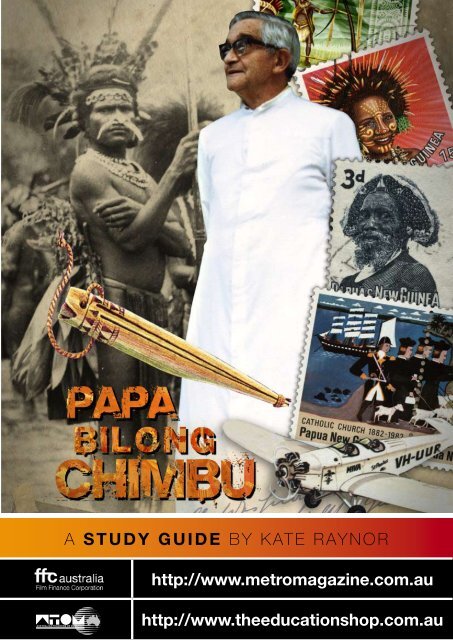
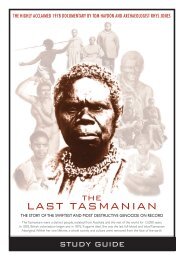

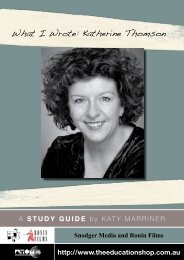
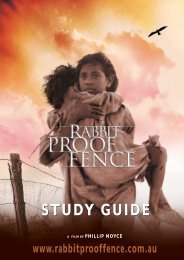

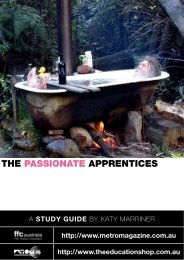
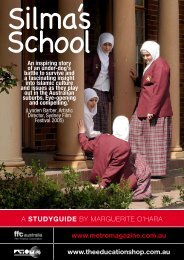
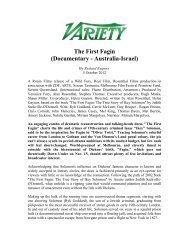

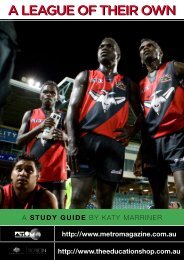
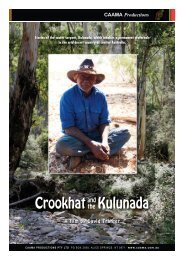
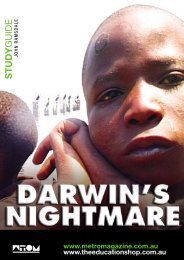
![to download FROHE OSTERN! [HAPPY EASTER!] - Ronin Films](https://img.yumpu.com/33740736/1/184x260/to-download-frohe-ostern-happy-easter-ronin-films.jpg?quality=85)
